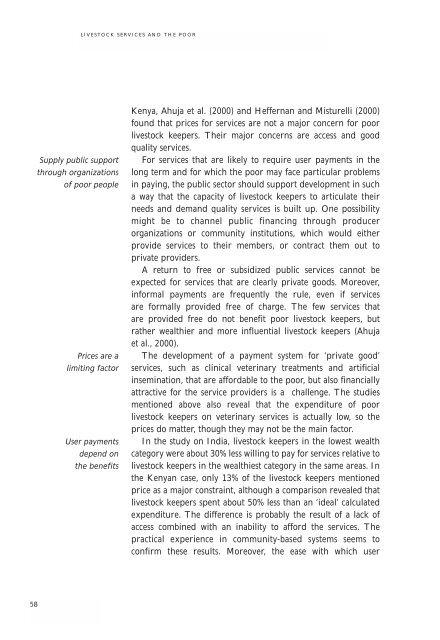Livestock Services and the Poor: A global initiative - IFAD
Livestock Services and the Poor: A global initiative - IFAD
Livestock Services and the Poor: A global initiative - IFAD
Create successful ePaper yourself
Turn your PDF publications into a flip-book with our unique Google optimized e-Paper software.
58<br />
Supply public support<br />
through organizations<br />
of poor people<br />
LIVESTOCK SERVICES AND THE POOR<br />
Prices are a<br />
limiting factor<br />
User payments<br />
depend on<br />
<strong>the</strong> benefits<br />
Kenya, Ahuja et al. (2000) <strong>and</strong> Heffernan <strong>and</strong> Misturelli (2000)<br />
found that prices for services are not a major concern for poor<br />
livestock keepers. Their major concerns are access <strong>and</strong> good<br />
quality services.<br />
For services that are likely to require user payments in <strong>the</strong><br />
long term <strong>and</strong> for which <strong>the</strong> poor may face particular problems<br />
in paying, <strong>the</strong> public sector should support development in such<br />
a way that <strong>the</strong> capacity of livestock keepers to articulate <strong>the</strong>ir<br />
needs <strong>and</strong> dem<strong>and</strong> quality services is built up. One possibility<br />
might be to channel public financing through producer<br />
organizations or community institutions, which would ei<strong>the</strong>r<br />
provide services to <strong>the</strong>ir members, or contract <strong>the</strong>m out to<br />
private providers.<br />
A return to free or subsidized public services cannot be<br />
expected for services that are clearly private goods. Moreover,<br />
informal payments are frequently <strong>the</strong> rule, even if services<br />
are formally provided free of charge. The few services that<br />
are provided free do not benefit poor livestock keepers, but<br />
ra<strong>the</strong>r wealthier <strong>and</strong> more influential livestock keepers (Ahuja<br />
et al., 2000).<br />
The development of a payment system for ‘private good’<br />
services, such as clinical veterinary treatments <strong>and</strong> artificial<br />
insemination, that are affordable to <strong>the</strong> poor, but also financially<br />
attractive for <strong>the</strong> service providers is a challenge. The studies<br />
mentioned above also reveal that <strong>the</strong> expenditure of poor<br />
livestock keepers on veterinary services is actually low, so <strong>the</strong><br />
prices do matter, though <strong>the</strong>y may not be <strong>the</strong> main factor.<br />
In <strong>the</strong> study on India, livestock keepers in <strong>the</strong> lowest wealth<br />
category were about 30% less willing to pay for services relative to<br />
livestock keepers in <strong>the</strong> wealthiest category in <strong>the</strong> same areas. In<br />
<strong>the</strong> Kenyan case, only 13% of <strong>the</strong> livestock keepers mentioned<br />
price as a major constraint, although a comparison revealed that<br />
livestock keepers spent about 50% less than an ‘ideal’ calculated<br />
expenditure. The difference is probably <strong>the</strong> result of a lack of<br />
access combined with an inability to afford <strong>the</strong> services. The<br />
practical experience in community-based systems seems to<br />
confirm <strong>the</strong>se results. Moreover, <strong>the</strong> ease with which user

















